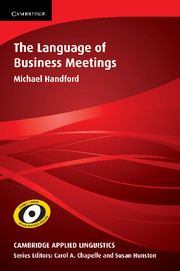Book contents
- Frontmatter
- Contents
- Series editors' preface
- Acknowledgements
- Transcription conventions
- 1 CANBEC: Corpus and context
- 2 Background: Theory and methodology
- 3 The business-meeting genre: Stages and practices
- 4 Significant meeting words: Keywords and concordances
- 5 Discourse marking and interaction: Clusters and practices
- 6 Interpersonal language
- 7 Interpersonal creativity: Problem, issue, if, and metaphors and idioms
- 8 Turn-taking: Power and constraint
- 9 Teaching and learning implications
- Appendix
- Index
2 - Background: Theory and methodology
Published online by Cambridge University Press: 05 April 2013
- Frontmatter
- Contents
- Series editors' preface
- Acknowledgements
- Transcription conventions
- 1 CANBEC: Corpus and context
- 2 Background: Theory and methodology
- 3 The business-meeting genre: Stages and practices
- 4 Significant meeting words: Keywords and concordances
- 5 Discourse marking and interaction: Clusters and practices
- 6 Interpersonal language
- 7 Interpersonal creativity: Problem, issue, if, and metaphors and idioms
- 8 Turn-taking: Power and constraint
- 9 Teaching and learning implications
- Appendix
- Index
Summary
Many of the features examined in this book have also been studied elsewhere using corpora of discourse from various institutional environments, and have been shown to be extremely useful in establishing the ‘fingerprints’ of individual genres and discourses. For instance, ‘keywords’ (statistically significant words in a particular register or genre) (Scott, 1999) have been shown to signal both the core content vocabulary (Tribble, 2002) and interpersonal features (McCarthy and Handford, 2004) in academic and spoken business discourse respectively. Clusters, or multiword units (Wray, 2002), and their related functions have been fruitfully studied in business meetings (McCarthy and Handford, 2004; Handford, 2007; O'Keeffe et al., 2007) and in academic discourse (Biber and Conrad, 1999; Oakey, 2002; Simpson, 2004; O'Keeffe et al., 2007), as has turn-taking (Walsh, 2006; Evison, 2008). Specific interpersonal markers of genre such as vagueness and hedging have been studied in media discourse (O'Keeffe, 2003, 2006), healthcare discourse (Adolphs et al., 2007) and academic discourse (Hyland, 1998; Evison et al., 2007), and metaphors and idioms have been analysed in spoken business discourse (Koester, 2006; Handford, 2007; Handford and Koester, 2010). In each case, these linguistic features have been shown to serve conventionalized purposes within their domains of discourse.
- Type
- Chapter
- Information
- The Language of Business Meetings , pp. 23 - 59Publisher: Cambridge University PressPrint publication year: 2010

